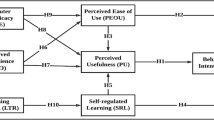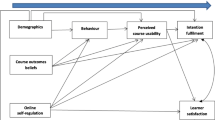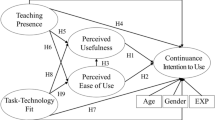Abstract
The massive open online course (MOOC) is emerging as the new paradigm for modern education. The success of MOOCs depends on learners’ continued usage. Drawing upon the information systems success model (IS success model) and technology acceptance model, a theoretical model for studying learners’ continuance intentions toward participation in MOOCs was developed. Based on survey data from 294 respondents, structural equation modeling was employed to assess the model. The results of this analysis indicate that system quality, course quality, and service quality were significant antecedents of the continuance intention of individuals, and the effect of course quality and service quality were mediated by perceived usefulness. The results contribute to the extant literatures in the context of MOOCs learning by identifying the critical quality factors, and provide managerial guidelines for MOOCs utilization and generalization. The implications of the present findings for research and managerial practice are discussed.




Similar content being viewed by others
References
Anderson, J. C., & Gerbing, D. W. (1988). Structural equation modeling in practice—a review and recommended 2-step approach. Psychological Bulletin, 103(3), 411–423.
Baron, R. M., & Kenny, D. A. (1986). The moderator-mediator variable distinction in social psychological research: Conceptual, strategic, and statistical considerations. Journal of Personality and Social Psychology, 51(6), 1173–1182.
Benbasat, I., & Barki, H. (2007). Quo vadis, TAM? Journal of the Association for Information Systems, 8(4), 211–218.
Bhattacherjee, A. (2001). Understanding information systems continuance: An expectation-confirmation model. MIS Quarterly, 25(3), 351–370.
Bhattacherjee, A., & Sonford, C. (2006). Influence processes for information technology acceptance: An elaboration likelihood model. MIS Quarterly, 30(4), 805–825.
Bhuasiri, W., Xaymoungkhoun, O., Zo, H., Rho, J. J., & Ciganek, A. P. (2012). Critical success factors for e-learning in developing countries: A comparative analysis between ICT experts and faculty. Computers & Education, 58(2), 843–855.
Calisir, F., Gumussoy, C. A., Bayraktaroglu, A. E., & Karaali, D. (2014). Predicting the intention to use a web-based learning system: perceived content quality, anxiety, perceived system quality, image, and the technology acceptance model. Human Factors and Ergonomics in Manufacturing and Service Industries, 24(5), 515–531.
Chang, S. C., & Tung, F. C. (2008). An empirical investigation of students’ behavioral intentions to use the online learning course websites. British Journal of Educational Technology, 39(1), 71–83.
Chen, I. Y. L. (2007). The factors influencing members’ continuance intentions in professional virtual communities: A longitudinal study. Journal of Information Science, 33(4), 451–467.
Cheng, B., Wang, M. H., Yang, S. J. H., Kinshuk, & Peng, J. (2011). Acceptance of competency-based workplace e-learning systems: Effects of individual and peer learning support. Computers & Education, 57(1), 1317–1333.
Chin, W. W., Marcolin, B. L., & Newsted, P. R. (2003). A partial least squares latent variable modeling approach for measuring interaction effects: Results from a Monte Carlo simulation study and an electronic-mail emotion/adoption study. Information Systems Research, 14(2), 189–217.
Chiu, C. M., Chiu, C. S., & Chang, H. C. (2007). Examining the integrated influence of fairness and quality on learners’ satisfaction and Web-based learning continuance intention. Information Systems Journal, 17(3), 271–287.
Chiu, C. M., Hsu, M. H., Sun, S. Y., Lin, T. C., & Sun, P. C. (2005). Usability, quality, value and e-learning continuance decisions. Computers & Education, 45(4), 399–416.
Cusumano, M. A. (2013). Are the costs of ‘Free’ too high in online education? Communications of the ACM, 56(4), 26–29.
Davis, F. D., Bagozzi, R. P., & Warshaw, P. R. (1989). User acceptance of computer-technology—a comparison of 2 theoretical-models. Management Science, 35(8), 982–1003.
Davis, F. D., & Venkatesh, V. (1996). A critical assessment of potential measurement biases in the technology acceptance model: Three experiments. International Journal of Human-Computer Studies, 45(1), 19–45.
De Freitas, S. I., Morgan, J., & Gibson, D. (2015). Will MOOCs transform learning and teaching in higher education? Engagement and course retention in online learning provision. British Journal of Educational Technology, 46(3), 455–471.
DeLone, W. H., & McLean, E. R. (1992). Information systems success: The quest for the dependent variable. Information Systems Research, 3(1), 60–95.
DeLone, W. H., & McLean, E. R. (2003). The DeLone and McLean model of information systems success: A ten-year update. Journal of Management Information Systems, 19(4), 9–30.
Fini, A. (2009). The technological dimension of a massive open online course: The case of the CCK08 course tools. International Review of Research in Open and Distance Learning, 10(5), 26.
Hew, K. F., & Cheung, W. S. (2014). Students’ and instructors’ use of massive open online courses (MOOCs): Motivations and challenges. Educational Research Review, 12, 45–58.
Hu, J. H. P., Brown, S. A., Thong, J. Y. L., Chan, F. K. Y., & Tam, K. Y. (2009). Determinants of service quality and continuance intention of online services: The case of e Tax. Journal of the American Society for Information Science and Technology, 60(2), 292–306.
Lee, J. K., & Lee, W. K. (2008). The relationship of e-Learner’s self-regulatory efficacy and perception of e-Learning environmental quality. Computers in Human Behavior, 24(1), 32–47.
Lewis, W., Agarwal, R., & Sambamurthy, V. (2003). Sources of influence on beliefs about information technology use: an empirical study of knowledge workers. MIS Quarterly, 27(4), 657–678.
Li, Y., Duan, Y., Fu, Z., & Alford, P. (2012). An empirical study on behavioral intention to reuse e-learning systems in rural China. British Journal of Educational Technology, 43(6), 933–948.
Liaw, S. S., Huang, H. M., & Chen, G. D. (2007). An activity-theoretical approach to investigate learners’ factors toward e-learning systems. Computers in Human Behavior, 23(4), 1906–1920.
Lin, K. M. (2011). E-Learning continuance intention: Moderating effects of user e-learning experience. Computers & Education, 56(2), 515–526.
Lin, K.-M., Chen, N.-S., & Fang, K. (2011). Understanding e-learning continuance intention: a negative critical incidents perspective. Behavior and Information Technology, 30(1), 77–89.
Lin, J. C., & Lu, H. (2000). Towards an understanding of the behavioral intention to use a web site. International Journal of Information Management, 20(3), 197–208.
Molla, A., & Licker, P. (2001). E-commerce systems success: An attempt to extend and respecify the DeLone and McLean model of IS success. Journal of Electronic Commerce Success, 2(4), 131–141.
Parasuraman, A., Zeithaml, V. A., & Berry, L. L. (1985). A conceptual-model of service quality and its implications for future-research. Journal of Marketing, 49(4), 41–50.
Pavlou, P. A., & Fygenson, M. (2006). Understanding and predicting electronic commerce adoption: An extension of the theory of planned behavior. MIS Quarterly, 30(1), 115–143.
Rai, A., Lang, S. S., & Welker, R. B. (2002). Assessing the validity of IS success models: An empirical test and theoretical analysis. Information Systems Research, 13(1), 50–69.
Roca, J. C., Chiu, C. M., & Martinez, F. J. (2006). Understanding e-learning continuance intention: An extension of the technology acceptance model. International Journal of Human-Computer Studies, 64(8), 683–696.
Saeed, K. A., Hwang, Y., & Yi, M. Y. (2003). Toward an integrative framework for online consumer behavior research: A meta-analysis approach. Journal of End User Computing, 15(4), 1–26.
Sanchez-Gordon, S., and Lujan-Mora, S. (2013). Accessibility considerations of massive online open courses as creditable courses in engineering programs. 6th International Conference of Education, Research and Innovation (Iceri 2013), 5853-5862.
Seddon, P. B. (1997). A respecification and extension of the DeLone and McLean model of IS success. Information Systems Research, 8(3), 240–253.
Spector, J. M. (2014). Remarks on MOOCSMOOCS and Mini-MOOCSMOOCS. Educational Technology Research and Development, 62(3), 385–392.
Sun, P. C., Tsai, R. J., Finger, G., Chen, Y. Y., & Yeh, D. (2008). What drives a successful e-Learning? An empirical investigation of the critical factors influencing learner satisfaction. Computers & Education, 50(4), 1183–1202.
Temme, D., Kreis, H., & Hildebrandt, L. (2006). PLS Path Modeling-A Software Review, SFB 694 discussion paper. Institute of Marketing: Humboldt-University Berlin, Berlin.
Venkatesh, V., & Davis, F. D. (2000). A theoretical extension of the technology acceptance model: Four longitudinal field studies. Management Science, 46(2), 186–204.
Venkatesh, V., Morris, M. G., Davis, G. B., & Davis, F. D. (2003). User acceptance of information technology: Toward a unified view. MIS Quarterly, 27(3), 425–478.
Wang, H. C., & Chiu, Y. F. (2011). Assessing e-learning 2.0 system success. Computers & Education, 57(2), 1790–1800.
Wang, Y. S., Wang, H. Y., & Shee, D. Y. (2007). Measuring e-learning systems success in an organizational context: Scale development and validation. Computers in Human Behavior, 23(4), 1792–1808.
Wu, B., & Zhang, C. (2014). Empirical study on continuance intentions towards E-Learning 2.0 systems. Behavior & Information Technology, 33(10), 1027–1038.
Yousef, A. M. F., Chatti, M. A., Schroeder, U., and Wosnitza, M. (2014). What drives a successful MOOCS? An empirical examination of criteria to assure design quality of MOOCs. Paper presented at the 14th IEEE International Conference on Advanced Learning Technologies (ICALT)—Advanced Technologies for Supporting Open Access to Formal and Informal Learning, Athens, Greece.
Zhang, Y., Fang, Y., Wei, K., & Wang, Z. (2012). Promoting the intention of students to continue their participation in e-learning systems: the role of the communication environment. Information Technology & People, 25(4), 356–375.
Zhou, T. (2013). An empirical examination of continuance intention of mobile payment services. Decision Support Systems, 54(2), 1085–1091.
Acknowledgements
This work was supported in part by grants from the National Natural Science Foundation of China (Nos. 71301172, 71301035) and the Beijing Higher Education Young Elite Teacher Project (No. YETP1001).
Author information
Authors and Affiliations
Corresponding author
Rights and permissions
About this article
Cite this article
Yang, M., Shao, Z., Liu, Q. et al. Understanding the quality factors that influence the continuance intention of students toward participation in MOOCs. Education Tech Research Dev 65, 1195–1214 (2017). https://doi.org/10.1007/s11423-017-9513-6
Published:
Issue Date:
DOI: https://doi.org/10.1007/s11423-017-9513-6




